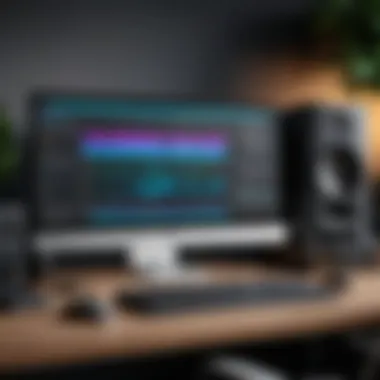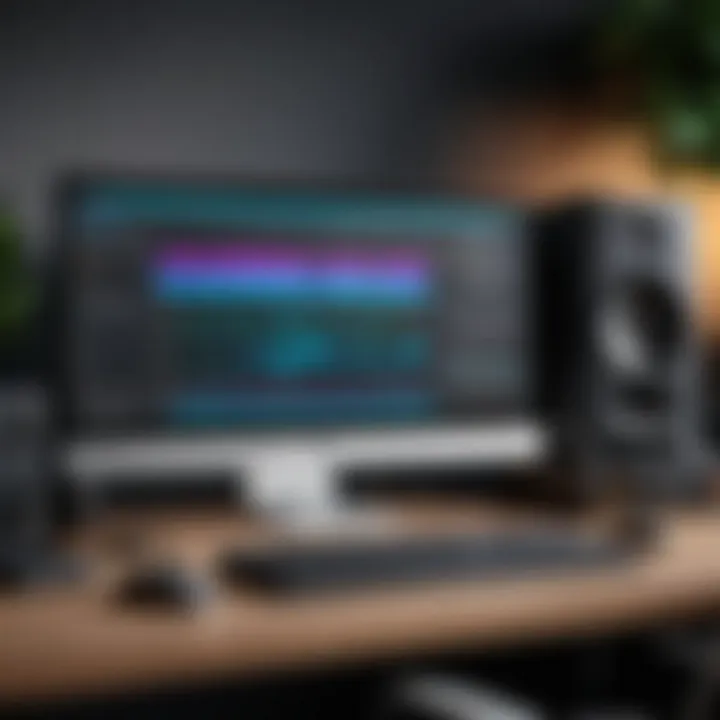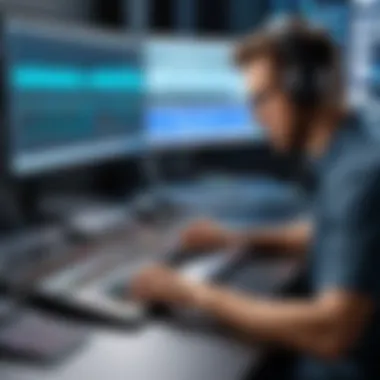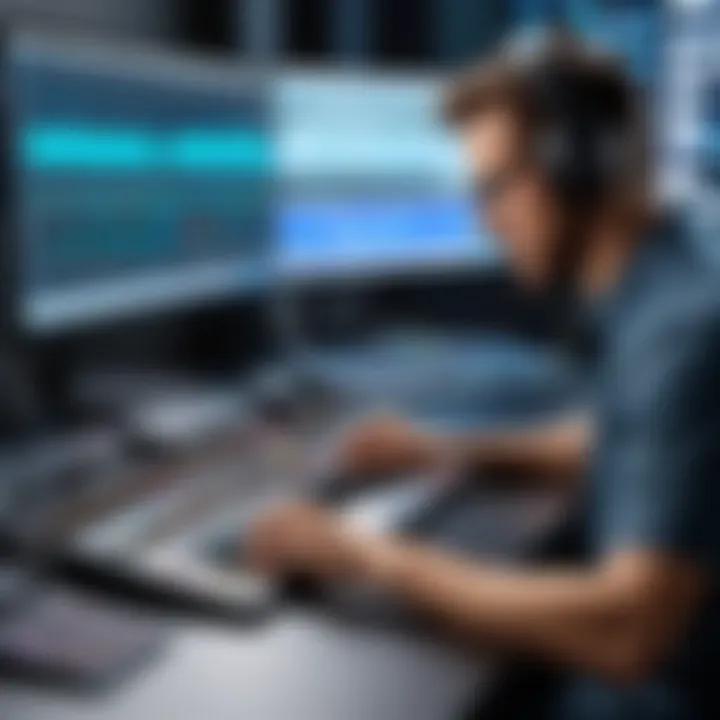Understanding the Vital Role of a Professional Audio Editor


Intro
In the realm of audio production, the role of an audio editor often goes unnoticed, yet it serves as the backbone to high-quality sound across various mediums. Whether it’s a blockbuster film, a chart-topping album, or a live broadcast, the expertise of a professional audio editor can make or break the final product. An audio editor does more than just cut and splice tracks; they curate experiences and add depth to the aural landscape, ensuring that everything fits seamlessly into the final mix.
This article delves deep into the responsibilities and importance of audio editing, highlighting the specialized skills required and tools necessary for success in this evolving field. We will explore the boundaries between audio editing and production, illuminating career pathways and insights into current technology trends. Readers will gain a clearer understanding of why an audio editor is an indispensable asset in various industries, including music, film, and broadcasting.
Overview of Software
From digital audio workstations (DAWs) to noise reduction tools, professional audio editors rely on a variety of software to hone their craft. Understanding the purpose and use cases of these tools is crucial for those looking to excel in audio editing.
Purpose and Use Cases
Audio editing software is designed to allow editors to manipulate sound, repair issues, and enhance audio quality. Here are a few of the typical use cases:
- Music production: Editing tracks for albums or live performances.
- Film scores: Aligning audio with visual components for a cohesive narrative.
- Broadcasting: Ensuring clarity and quality for radio shows or podcasts.
Key Features
Most audio editing programs come equipped with a range of functionalities:
- Multi-track editing: Enables simultaneous work on multiple audio layers.
- Audio restoration: Tools that remove unwanted noise, clicks, or hums.
- Effect processing: Options for reverb, compression, and equalization to enhance the sound.
In-Depth Review
To choose the right software, one must analyze performance and user experience. Let’s explore some of the standout software in this league.
Performance Analysis
The effectiveness of an audio editing software can be gauged by its processing speed, stability, and the absence of lag during playback. For example, programs like Avid Pro Tools provide robust performance, especially for larger projects, which is essential in professional settings.
User Interface and Experience
The design of the software interface can heavily influence the workflow efficiency. Intuitive layouts and accessible features can drastically improve an editor's speed. For instance, Ableton Live offers a unique session view that allows for quick audio manipulation and real-time collaboration, making it a favorite for many musicians and editors.
"An editor's ability to make quick adjustments can save hours of work and lead to a polished product that resonates with audiences."
As we navigate through the audio landscape, one thing remains evident: the combination of technical know-how and artistic flair is what truly defines a successful audio editor. In the next sections, we will dive deeper into the essential skills and career pathways, shedding light on how one can aspire to thrive in this fascinating field.
Intro to Audio Editing
Audio editing is more than just cutting and splicing sounds together; it is an art form that demands precision, creativity, and technical skills. In understanding audio editing, one begins to appreciate how crucial this field is to various industries such as music, film, and broadcasting. Each aspect of audio editing contributes significantly to the overall quality of the finished product, enhancing the message the audio seeks to convey. Moreover, with the rapid advancements in technology today, audio editing has evolved, introducing new tools and techniques that redefine how we experience sound.
Defining Audio Editing
At its core, audio editing consists of manipulating audio recordings to improve, refine, or create new audio content. This practice can encompass several tasks including trimming unnecessary parts, adjusting levels, and layering different sounds. To further clarify, an audio editor might take a raw recording of a podcast and ensure that each speaker's voice is clear, free of distractions, and harmoniously mixed with background music. This not only enhances listener engagement but also shapes the overall tone and mood of the piece.
Some may refer to it as "cleaning up" a recording, which encapsulates the essence of audio editing well. Various types of audio content can benefit from professional editing, including:
- Podcasts: Here, audio editing ensures clarity and cohesiveness in storytelling.
- Music Tracks: For musicians, it’s about perfecting the sound and correcting imperfections.
- Films: In this realm, sound is interwoven with visuals to create an immersive experience.
In essence, audio editing serves as a bridge between raw audio and the polished product that reaches the audience.
Historical Context
The practice of audio editing has come a long way from its inception. Originally, audio editing required physical manipulation of tape, a process demanding both skill and time. In the early days of the music industry, musicians and producers would physically cut tape using razor blades, rearranging audio clips to craft a final product. It was tedious work that involved a steep learning curve.
As technology progressed, the introduction of digital audio workstations marked a significant turning point. With software like Pro Tools and Adobe Audition, editing became faster and more efficient, opening doors for aspiring audio editors. These advancements also democratized audio production, allowing more individuals to experiment with sounds regardless of technical background.
Today’s audio editing landscape brims with opportunity, thanks to the rise of online tutorials, forums, and educational resources. Recent tools do much of the heavy lifting, helping editors focus on creativity. Thus, the story of audio editing reflects broader technological shifts, illustrating how innovation can reshape industries and change the roles required within them.
The Skillset of a Professional Audio Editor
The role of a professional audio editor encompasses a variety of skills, each crucial in shaping the final sound product. This section delves into the core components of this skillset, highlighting why these attributes matter not just in the context of work but also in setting one apart in an ever-evolving industry.
Technical Proficiency
Technical proficiency is the backbone of what an audio editor does. It involves a solid grasp of software tools such as Pro Tools, Adobe Audition, or Logic Pro X. Mastery of these programs allows an editor to manipulate sound with precision and efficiency.
But it's not just familiarity with tools; it's about knowing how to use them effectively. An adept audio editor will understand how to apply effects, adjust levels, and mix tracks seamlessly. This know-how can make or break the clarity and quality of audio during post-production. Understanding the technical intricacies of formats, sample rates, and bit depths is equally important, as it influences the final output based on the medium it will be aired on.
Moreover, keeping up with the latest trends in technology is vital. The rise of AI and automation tools can now assist in tasks like noise reduction and sound enhancement. An audio editor who can navigate these new landscapes skillfully will certainly give themselves a competitive edge.
Creative Vision


Creative vision is as vital as technical knowledge in the audio editing field. Editors must bring an artistic touch to their work, something that cannot be automated or learned through software manuals alone. This is about having a keen ear for sound—recognizing what works and what doesn’t in a musical piece or a voice-over.
When working on projects, audio editors often need to collaborate closely with producers, directors, and sound designers. Each of these roles involves a unique perspective on what the final product should convey. A creative audio editor will understand the nuances of storytelling and can convey emotions through sound, enhancing the audience's engagement.
Thinking outside the box can lead to innovative uses of sound effects or unique mixing styles that can solidify a project’s identity. Perhaps an editor will layer ambient sounds to create a specific atmosphere, or they might use experimental techniques to highlight certain elements of a track.
Attention to Detail
Attention to detail is non-negotiable in audio editing. Each sound, from the faintest whisper to loud explosions, needs to be positioned accurately to ensure a balanced and cohesive audio experience. An audio editor must possess the ability to catch minor glitches, responsible for pulling the audience out of the moment.
Editing audio involves a lot of small, tedious tasks: aligning tracks, tweaking volumes, and making sure transitions flow smoothly. The devil is in the details, after all. Missing even a small mistake can change the meaning of a dialogue or the feel of a song.
Not only that, but an audio editor has to be organized. Managing multiple tracks, files, and versions necessitates a systematic approach, almost like an artist working on an elaborate sculpture, chipping away at each detail until it’s just right. This attention also extends into the realm of feedback—embracing constructive criticism and adjusting work based on suggestions can lead to a far stronger final product.
"An audio editor not only crafts sound, but also shapes perception through a delicate balance of technical know-how and artistic flair."
In summary, the skillset of a professional audio editor is as multifaceted as the field itself. With a blend of technical know-how, creative vision, and meticulous attention to detail, audio editors hold the power to transform raw sound into polished auditory experiences. These skills are indispensable, ensuring that professionals not only survive but thrive in an increasingly competitive landscape.
Tools and Software for Audio Editing
The landscape of audio editing is heavily influenced by the tools and software that professionals use. These tools not only shape the quality of sound produced but also dictate the efficiency and creativity of the editing process. By investing in the right equipment and programs, an audio editor can navigate the complexities of sound design and production with relative ease.
Digital Audio Workstations (DAWs)
Digital Audio Workstations are the backbone of modern audio editing. Take, for example, software like Pro Tools, Ableton Live, or Logic Pro. These platforms serve as a comprehensive environment where sound can be recorded, mixed, and edited with precision. Using a DAW, an editor can manage multiple tracks, apply effects, and utilize automation to enhance their projects.
When choosing a DAW, several factors come into play. Considerations such as user interface preference, compatibility with different operating systems, and community support are vital. A flawed choice in a DAW can lead to a steep learning curve, inflicting headaches on even the most seasoned editors.
Moreover, each DAW exhibits unique strengths; for instance, Ableton Live is prized for its performance capabilities, making it favorable among electronic music producers. Understanding these traits can help aspiring audio editors align their tools with their specific needs or workflows.
Plugins and Effects
Plugins and effects add further depth and color to audio editing. They are akin to spices in a chef’s kitchen; a little can enhance the flavor dramatically. Audio editors use various plugins to manipulate sound to suit their artistic vision. Popular options might include Waves, iZotope, and FabFilter. Each of these companies offers an extensive array of sound-shaping tools, from equalizers to reverb units.
However, it's crucial to approach plugins judiciously. While the temptation is to pile on layers of effects, sometimes less is more. Overprocessing can mud up the mix, robing it of clarity. Instead, mastering the correct application of a few quality plugins is like honing a craft—it takes time and practice but yields gratifying results.
Hardware Requirements
You can have the best software in the world, but without the right hardware, it won’t perform at its peak. A well-balanced audio workstation consists of powerful processors, adequate RAM, and sufficient storage space. Additionally, professionals invest in specialized audio interfaces and monitors. Focusrite Scarlett, for example, is a notable audio interface, allowing for high-quality sound input and output.
Consider the effect of hardware on latency, too. A high-quality interface minimizes delays, which is especially important in real-time sound applications. For monitors, investing in KRK Rokit speakers can ensure that what you hear is true to the recorded sound, allowing for better mixing decisions.
In summary, the tools and software of audio editing are much more than mere instruments; they forge the foundation on which a professional editor crafts their sound. The mastery of these elements requires both knowledge and experience, ultimately leading to a production that resonates with the audience.
Distinction Between Audio Editing and Production
Understanding the difference between audio editing and production is crucial for anyone involved in the audio landscape. To some, these two terms may seem interchangeable, but there exist significant nuances that differentiate them.
Audio editing is fundamentally about refining recorded sound. It entails a variety of activities like trimming, rearranging, and enhancing audio tracks. Essentially, it's the art of manipulating sound materials to achieve a polished final product. However, when we talk about audio production, we're diving deeper into the broader process that encompasses not just the editing but also the creation, arrangement, mixing, and mastering of music or sounds for films, podcasts, and other media.
The distinction matters for several reasons:
- Scope of Work: Audio editing zeroes in on the specifics of sound manipulation, while production is about the entire sound landscape.
- Skill Sets Involved: An audio editor typically requires a good ear and technical proficiency in tools, whereas producers often need a broader skill set, including project management and a visionary approach to the final audio experience.
- Collaboration Dynamics: The relationship between editors and producers can sometimes blur, yet it's important to recognize that their roles complement rather than overlap.
Therefore, acknowledging these differences not only clarifies roles within the industry but also enhances collaboration.
Understanding the Differences
A simple way to think about this is through analogy. If audio editing is akin to painting a house, then audio production is the entire construction process – from laying down the foundation to decorating the interiors. Each has its unique demands, timeframes, and essential checkpoints.
- Components of Audio Editing:
- Components of Audio Production:
- Trimming and Cutting: Removing unwanted sections to tighten the audio flow.
- Arranging Tracks: Placing audio segments in a coherent sequence.
- Adding Effects: Applying echoes or reverbs which enhance the auditory experience.
- Composition: Crafting the original music or sound design.
- Arrangement: Structuring how the different audio elements work together.
- Mixing and Mastering: Finalizing the audio balance and preparing the final mix for distribution.
Collaboration with Producers and Engineers
When audio editors, producers, and sound engineers collaborate effectively, the outcome can be nothing short of extraordinary. Each role brings a unique set of skills to the table.
- Producers often guide the creative direction. They may develop the initial concept and ensure that it resonates with the intended audience. The producer’s vision can influence the audio’s final shape, making their input invaluable during the entire process.
- Audio Engineers tackle the technical aspects of sound. They manage equipment and ensure optimal recording quality, while also handling mixing and mastering tasks. Their understanding of acoustics and sound behavior is critical, particularly in high-stakes settings like film and music production.
The collaboration dynamics often play out through ongoing dialogues during project phases. For example, an audio editor may receive feedback from a producer regarding specific edits they made, ensuring that the vision aligns throughout the creation process. This mesh of creative energies typically forms a robust production team.


Common Techniques in Sound Editing
Audio editing is an intricate art that balances technical knowledge and creative intuition. Among the various facets of audio editing, employing common techniques is pivotal. It's through these methods that editors shape a raw soundscape into a polished auditory experience. Understanding these techniques not only elevates the quality of the final product but also makes it more engaging for the audience.
Noise Reduction
Noise reduction is often the unsung hero in the realm of audio editing. Every recording has its fair share of unwanted sounds, be it hums, clicks, or background chatter, that can detract from the main audio. Using advanced noise reduction software, audio editors can effectively minimize these interferences.
The significance of this technique comes into play especially during post-production. Imagine a compelling interview overshadowed by distracting noises. A professional audio editor can salvage that scenario, ensuring that the listener focuses solely on the conversation. Noise reduction not only enhances clarity but also fosters a more immersive listening experience. Editors must, however, strike a balance so that vital audio nuances aren’t inadvertently removed in the process.
Equalization
Equalization, or EQ as it's often referred to in casual conversations, is another cornerstone of sound editing. This technique allows editors to adjust the balance of specific frequency ranges in audio recordings. The primary aim is to enhance certain elements of the sound while reducing others, fine-tuning audio to achieve that perfect harmony.
For instance, by boosting the mid-range frequencies in a vocal track while lowering certain bass tones, an audio editor can enhance vocal clarity without muddying the overall mix. This customization not just improves the tonal quality but also can change the emotional impact of the piece. In film, for instance, the emotional weight of a scene can be transformed through selective EQ adjustments. Understanding the nuances of equalization and its importance is crucial for any aspiring audio editor.
Dynamic Range Compression
Dynamic range compression is the secret sauce that can make or break a track. This technique balances the loudness of a sound by reducing the difference between the softest and loudest parts of an audio file. When done correctly, it lends a sense of cohesiveness to the listening experience.
Compression is especially valuable in genres where consistent volume levels are crucial, such as pop music or podcasting. For example, during a dramatic audio presentation, certain sounds may peak high while others may remain soft, risking listener engagement. By carefully applying dynamic range compression, an audio editor can ensure each component is heard clearly, maintaining the listener's attention throughout the piece.
"Great sound editing is like magic; it can transform the ordinary into something extraordinary."
In wrapping up this discussion on techniques, it's essential to recognize that mastering these methods is not simply about technical proficiency. Rather, it's about an editor’s ability to create a narrative through sound. Whether it's reducing noise to salvage a precious moment, eqing vocals for emotional resonance, or compressing dynamics for cohesion, every technique plays a vital role in the final auditory tapestry. With practice and experience, editors can harness these tools effectively, paving their path in the evolving audio landscape.
Career Opportunities in Audio Editing
The field of audio editing offers a diverse landscape of career opportunities, all rooted in the essential skill set that professionals build over time. Being adept at audio editing isn't just about knowing how to manipulate sound; it's about understanding the broader impact of audio in various industries. This section delves into the importance of these opportunities, highlighting key sectors where audio editors are in demand and weighing the pros and cons of freelancing versus full-time employment.
Industries That Require Audio Editors
There’s no denying that audio editors play a crucial role in multiple industries. Here are some key sectors that actively seek these talents:
- Music Industry: From recording studios to independent artists, music creation demands skilled audio editors for mixing tracks, removing noise, or even adjusting pitch. Each project can require a different skill set, tailored to the artist’s vision.
- Film and Television: Audio editors enhance the narrative of visual storytelling. They sync, mix, and edit soundtracks and dialogue, crafting an immersive auditory experience that complements the visuals.
- Broadcasting: Radio stations and television networks rely on audio editors for live shows and recorded segments, ensuring quality sound before airing. Timeliness and accuracy are paramount here, as a crisp broadcast can be the difference between engaging and losing an audience.
- Gaming: With the rise of interactive entertainment, video game audio has become increasingly complex. Audio editors here work on sound effects, voiceovers, and background scores that react to users’ actions, making their job both challenging and rewarding.
- Podcasting: The boom in podcasting has opened doors for numerous audio editors. High-quality sound is essential in this competitive space, mandating skilled editors to sharpen audio, remove distractions, and enhance overall production quality.
Each of these industries requires unique skills and approaches, underscoring the need for a versatile audio editor.
"The difference between a good audio editor and a great one can transform a decent project into a masterpiece, reverberating long after the sound fades away."
Freelancing vs. Full-Time Positions
Deciding between freelancing and full-time positions in audio editing can be a tough nut to crack, as both paths hold their own advantages and challenges. Here’s a breakdown:
Freelancing
- Flexibility: Freelancers can set their own schedules, picking projects that resonate with them. This flexibility can lead to higher job satisfaction, but also requires self-discipline to manage time effectively.
- Variety of Work: Freelancers often have the chance to work across different industries, which can be exciting. Exposure to various styles and techniques helps them become more adaptable.
- Potential for Higher Earnings: While freelancing can lead to inconsistent income, successful freelancers can strategically increase their rates as they build a reputation.
Full-Time Employment
- Job Security: A full-time position typically offers more financial stability, benefits, and a consistent workflow. It's a practical choice for many, especially early in their careers.
- Team Collaboration: In-house jobs often involve working within a team, which can lead to better networking opportunities and mentorship. It also provides a chance to learn from seasoned professionals.
- Career Progression: Many companies have structured paths for advancement. Those who start in entry-level positions often find opportunities for promotion, gaining new skills along the way.
Both paths require strong audio skills and a keen understanding of industry trends. Newcomers to the field should weigh their options carefully based on personal goals, lifestyle preferences, and financial considerations.
The Impact of Technology on Audio Editing
In the realm of audio editing, technology has revolutionized the landscape, shaping the workflows and methodologies of audio editors in profound ways. The evolution of tools and techniques has not only made editing faster but has also enriched creative possibilities. As a result, understanding the impact of technology is crucial for anyone involved in audio editing. This section delves into several key aspects, touching on innovation, efficiency, and collaborative practices.
Emergence of AI and Automation
Artificial intelligence is making quite a splash in audio editing, turning various tasks on their heads. AI-driven tools can analyze audio more efficiently than ever before, helping editors identify issues that might be missed by the human ear. For instance, tools like iZotope RX leverage machine learning to automatically remove background noise or adjust pitch. Furthermore, these advances allow for more advanced features, such as automatic mixing and mastering, sparing the editor hours of work.
However, it’s essential to keep a keen eye on the limitations. Despite AI’s prowess, it lacks the subjective judgment that human editors bring to the table. The art of storytelling through sound often relies on nuanced decisions that AI cannot easily replicate. Thus, while automation can streamline repetitive tasks, it cannot replace the need for a professional audio editor’s touch.
Trends in Remote Collaboration
The growth of digital communication tools has paved the way for remote collaboration in audio editing. Platforms like Zoom and Slack have become commonplace, facilitating real-time feedback between clients and editors regardless of geographical constraints. This interconnectedness seems to be here to stay, especially in the wake of a global pandemic that forced many to rethink traditional work environments.
Benefits of remote collaboration include:
- Wider talent access: Professionals can now work with clients or studios across the globe.
- Cost efficiency: Reduced overhead costs associated with physical studio spaces.
- Flexibility: Editors can work from virtually anywhere, leading to better work-life balance.
Nonetheless, this shift also presents challenges. The lack of in-person interaction can sometimes lead to miscommunication and unmet expectations. Technology may bridge distances but can’t fully replicate the chemistry formed in a physical studio.


The implications of technology in audio editing are significant. Moving forward, audio editors must adapt to these technologies while retaining the critical human elements that truly elevate sound editing beyond mere technicality. As technology continues to evolve, so too will the possibilities in the realm of professional audio editing.
"Technology, in itself, is not a problem. It is how we utilize it that defines our path forward."
For further reading:
You can explore the impacts of technology in media through resources such as Wikipedia or Britannica.
In synopsis, the adaptation to new technologies—like AI and remote collaboration tools—holds the key for audio editors aiming to thrive in a fast-paced industry that requires both technical skill and creative ingenuity.
Essential Learning Pathways
In the ever-evolving landscape of audio editing, having the right educational foundation is crucial. The need to keep pace with new techniques and technologies is what sets apart successful audio editors from the crowd. This is where essential learning pathways come into play, which encompass various types of education, training, and community engagement that help aspiring editors hone their craft.
A solid educational background not only provides the technical skills required but also sharpens creative instincts. Whether through formal schooling, online classes or self-directed learning, each pathway adds a unique layer to an individual’s expertise. Keeping up-to-date with industry changes is vital, as technology and trends continually shift.
Educational Programs and Certifications
Many universities and colleges offer specialized degrees in audio engineering or sound design. These programs teach students the fundamentals of sound theory while immersing them in practical experiences. Institutions such as Berklee College of Music and fullsail University have respected audio programs that often lead graduates into prominent positions within the field.
Certifications are another route worth considering. Programs offered by organizations such as Avid, known for Pro Tools software, provide targeted training. Gaining certifications can also give audio editors a competitive edge, showcasing their commitment to staying current with industry standards.
Some of the key benefits of pursuing formal programs or certifications include:
- Comprehensive Knowledge: Learning from established professionals in structured environments fosters deeper understanding.
- Networking Opportunities: Being part of educational institutions opens doors to connections that can be pivotal for future job opportunities.
- Hands-on Experience: Programs often include hands-on labs where students can practice techniques in real-time, touching the gear that professionals use.
Indeed, the investment in education pays off as it builds a strong foundation for a successful audio editing career. However, getting the credentials is just the tip of the iceberg.
Online Resources and Communities
In the age of the internet, there's a wealth of resources available for someone looking to dive into audio editing. Online platforms like Coursera, Udemy, and even YouTube host a treasure trove of tutorials ranging from beginner to advanced level. These resources help learners adapt based on their pacing, allowing them to experiment with various editing techniques without the constraints of formal education.
Moreover, community involvement can’t be overlooked. Websites like Reddit have numerous forums where professionals share insights, troubleshoot problems, and discuss the latest trends, enriching the learning experience. Besides, joining communities on platforms like Facebook or specialized forums can provide valuable peer support. Here are some benefits of engaging with online communities:
- Feedback Loop: Receiving critiques and suggestions from fellow editors can facilitate growth.
- Staying Updated on Trends: Networking with others in the field can keep you abreast of new tools and industry shifts.
- Diverse Perspectives: Learning from peers around the world brings fresh ideas and techniques which might be unfamiliar.
To summarize, whether it's through traditional programs or self-directed online learning, the pathways to mastering audio editing are diverse and plentiful. Each route complements different learning styles and career goals, ultimately fostering the next generation of audio artists. Engaging with both educational and community resources enables budding editors to develop their skills and ensures they remain relevant in a fast-paced industry.
Challenges Faced by Audio Editors
Audio editing is an intricate dance between creativity and technology. As the industry continues to evolve, audio editors find themselves navigating a range of challenges that demand both technical prowess and artistic sensibility. These challenges not only impact the editor's work but also influence the final output in various fields such as music, film, and broadcasting. Understanding these obstacles is vital for both current professionals and those aspiring to break into the field.
Balancing Artistic and Technical Demands
The role of an audio editor is inherently multifaceted. An editor must possess a keen ear for sound quality while being equipped with the technical skills to manipulate audio effectively. The requirement to strike a balance between artistic creativity and technical accuracy doesn't just keep editors on their toes; it also significantly impacts the message conveyed through audio. For instance, a simple mix-up in levels could transform a heartwarming podcast into a muddled noise, overshadowing the content's inherent value.
To tackle this balancing act, editors often rely on several strategies:
- Fostering a Collaborative Environment - Working closely with producers and sound engineers helps to ensure that both artistic vision and technical feasibility are harmoniously aligned.
- Continuous Learning - The landscape is ever-changing, which means keeping abreast of new trends, tools, and techniques.
- Prioritizing Feedback - Regularly soliciting input from peers can provide fresh perspectives, helping editors refine their approach to projects.
Staying Updated with Industry Changes
In a field as dynamic as audio editing, remaining in lockstep with industry changes is paramount. New technologies and tools emerge at breakneck speed, meaning that what was state-of-the-art yesterday might be outdated tomorrow. For example, the sudden rise of AI-driven editing software has changed the playing field. While such innovations promise increased efficiency, they also raise questions about the role of human editors. Can creativity be genuinely programmed? This uncertainty adds another layer of complexity to the role of an audio editor, raising valid concerns about job security and the essential human touch in sound editing.
Audio editors confront several pressing industry changes:
- Emerging Technologies: Keeping up with developments in digital audio workstations, plugins, and editing software is essential.
- Shifting Consumer Preferences: The advent of streaming services has altered audience expectations, placing greater emphasis on sound quality and immediacy.
- Ethical Considerations: The use of AI tools invites scrutiny regarding copyright issues, ownership of sound edits, and the essence of artistic creation.
Staying informed can mitigate these challenges and empower audio editors to remain relevant. By consistently investing in education and professional development, they position themselves to adapt and thrive amid the ongoing changes in the industry.
"In the world of audio editing, the only constant is change. The skills of yesterday might not apply to the challenges of tomorrow."
In summary, the challenges faced by audio editors underscore the complexity of their role. Balancing the artistic and technical elements of their work while staying updated with industry changes is crucial not only for their success but also for the quality of the audio they produce.
Final Thoughts on the Future of Audio Editing
In the ever-evolving world of audio editing, staying ahead of the curve is paramount for audio professionals. As technology continues to advance, understanding the future landscape of audio editing becomes essential. This section not only addresses anticipated technological innovations but also emphasizes the irreplaceable value of human creativity within this changing environment.
Predicted Developments in Audio Technology
With the rapid march of technological progress, the audio editing realm is set to face significant shifts. Experts predict that artificial intelligence will play a more prominent role by automating basic editing tasks. This automation can streamline workflows, allowing editors to focus on more complex, creative aspects of their projects. Here are some predicted developments:
- AI-Driven Editing Tools: Future audio editing software may incorporate advanced algorithms that can analyze audio content and make automatic adjustments. This could range from basic noise reduction to more intricate mixing processes, ultimately saving time.
- Immersive Audio Experiences: With the rise of virtual and augmented reality, there will be a growing need for audio editors proficient in creating 3D spatial audio files. Such content demands a new skill set that enables professionals to deliver sound experiences that resonate in a more immersive way.
- Enhanced Cross-Platform Collaboration: As remote work becomes more entrenched in various industries, tools that support collaborative editing in real time are on the horizon. Features allowing multiple audio editors to work simultaneously on a single project can enhance productivity and creativity.
These advancements, however, invite a crucial question: will the essence of audio editing remain intact? In answering that, we must pivot towards the next segment.
The Continuing Importance of Human Ingenuity
While technology can vastly improve efficiency, the artistry that comes from the mind of a skilled audio editor cannot be replicated. Human ingenuity plays a critical role in thoughtful audio editing for several reasons:
- Creative Judgment: Machines can analyze audio but they can’t discern artistic intent like humans can. A professional audio editor brings their unique interpretation to sound, tailoring each piece to fit a specific message or mood. This creative nuance contributes significantly to the overall quality of a project.
- Emotional Connection: Audio editing isn’t merely technical; it also communicates emotion and storytelling. An editor who understands how to evoke feelings through sound will always hold an advantage over any automated system.
- Problem-Solving Skills: Every project has its quirks and problems. Rather than relying solely on algorithms, efficient audio editors draw upon their past experiences, combining technical skills and creative thinking to resolve challenges effectively.
"Technology will change the tools we use, but the human touch remains irreplaceable in the art of audio editing."







